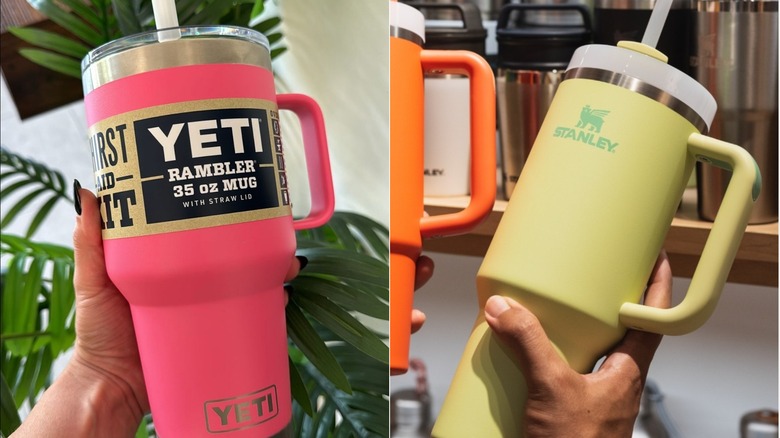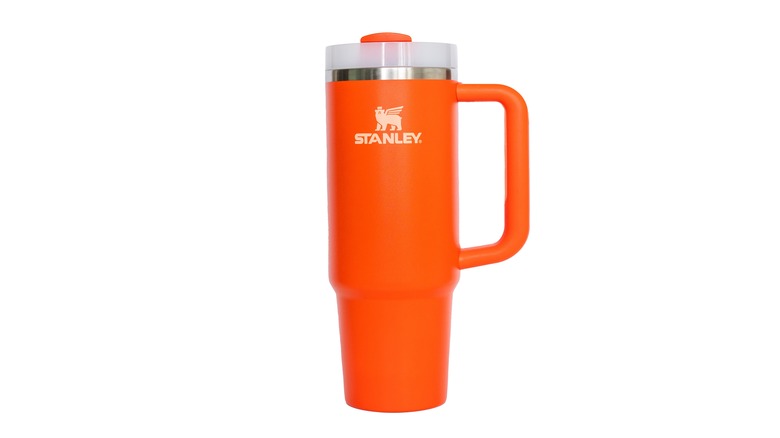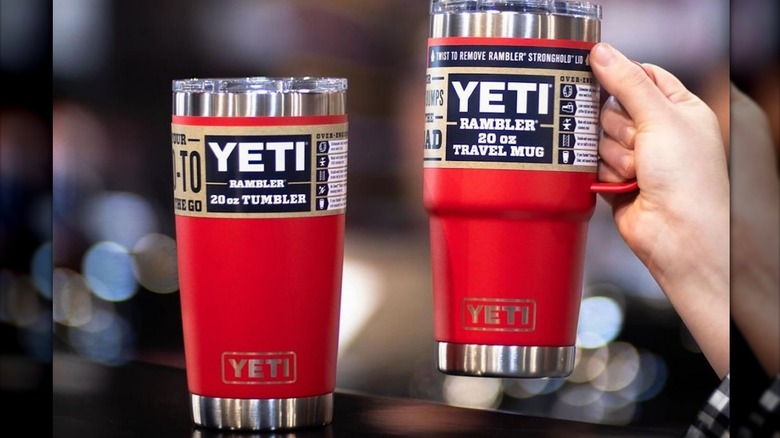Stanley Vs Yeti Tumblers: Here Are The Main Differences
First things first: The people who tell you your morning coffee "doesn't count" as hydrating are totally lying. Regardless, there are signs that you're probably still dehydrated — and between Stanley cups and Yeti tumblers, one of the internet's most health-conscious trends is here to help.
Stanley has been around since 1913, and Yeti since 2006, with the former leading to an internet craze in late 2023 that's still lingering. The large tumblers both feature a built-in handle and straw and are known for their quality and durability. In fact, to the untrained eye, the two look almost identical. So, are they?
Honestly, they're pretty similar products. The prices and look are comparable; they'll both fit nicely in your car's cup holder, and they're both well-renowned for keeping water chilled to perfection. But if you've had both tabs open on your computer for months trying to decide which to put on your holiday wish list, a few main things differentiate them.
First, Stanley offers a broader variety of consistent color and size options. Yeti has offered dozens of colors throughout its history but only keeps a few "core colors" in stock year-round, instead focusing on limited edition seasonal colors. Beyond aesthetics, their structure differs most significantly when it comes to the handle and the lid.
Here's what Stanley has going for them
William Stanley Jr. patented the steel-insulated bottle in 1913 and went on to create the Stanley Insulating Company. Like today, its products were known for durability, even carried by World War II pilots. But at some point, its primary audience shifted from those at war to those most likely to admire a lovely pastel color palette — and the rebranding wasn't an accident.
Around 2020, the company made the decision to intentionally cater to its female audience, recruiting social media influencers to turn the brand into a trend — and offering the cups in nearly every color imaginable. This includes more than 30 shades and a range of sizes from 14 to 64 ounces of capacity, although the smaller sizes lack a handle. Yeti also has an extensive color wheel of choices, but it doesn't quite meet Stanley's level of customization options.
The next big difference between the Stanley and Yeti tumblers is their lids. Stanley lids include three pieces: The main lid, the straw, and a sliding tab that rotates to reveal a straw opening, a wide mouth area for direct drinking, or a full-top cover. Unfortunately, the squishy plastic straw leaves space for leaking and may leak fast if knocked over, as well as spilling if it's jostled around too much. It may work better as a water bottle that stays put in the office or your home. If you do take it on the go, the tumbler promotes user comfort by featuring a large, padded handle.
Here's what Yeti has going for them
Yeti was founded by Roy and Ryan Seiders in 2006 to make quality outdoor equipment. It is still a staple in the outdoorsman community, known for its durability and functionality. Its lid falls right in line with this premise — with just two pieces and a firmer straw that fits snugly into the lid, the Yeti Rambler is less likely to leak onto your snacks during, say, a hike. It also offers a $10 add-on "magslider lid," which uses a removable magnet to cover the drinking hole for safer transportation. The Rambler also features a smaller, thinner handle, which is less padded than the Stanley's. Some people may prefer this tighter grasp, but there is a loss of comfortability.
Yeti also has a widely documented commitment to sustainability, including a buy-back and recycling program for used Yeti Ramblers, a reported 95% recyclable packaging rate, and regular donations to organizations focused on land restoration. This isn't to say that Stanley hasn't also remained committed to its sustainability goals: It has eliminated most of its plastic packaging and offers a lifetime product warranty. However, for those for whom sustainability is a priority, Yeti's focus on the outdoors may be a point of consideration when making their purchase.
Stanley and Yeti tumblers both have qualities that arguably make one worth buying over the other. But if you buy one, stick with it rather than treating it as disposable. At the end of the day, both of these tumblers (no matter what color) will keep you hydrated — and that's more important than a trend.


